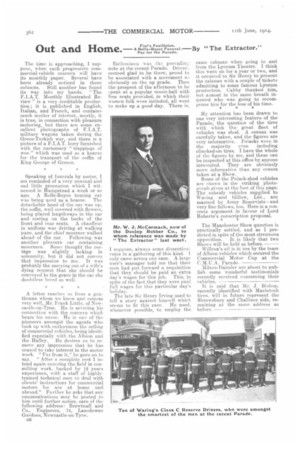Out and Home.
Page 18

If you've noticed an error in this article please click here to report it so we can fix it.
Fiat's Feuilleton.
A Rolls-Royce Funeral. Pay for the Parade.
By "The Extractor."
The time is approaching, I suppose, when each progressive commercial-vehicle concern will have its monthly paper. Several have been already noticed in these columns. Still another has found its way into my hands. " The F.I.A.T. Monthly Illustrated Review" is a very creditable production; it is published in English, Italian, and French, and contains much matter of interest, mostly, it is true, in connection with pleasure motoring, but there are some excellent photographs of F.I.A.T. military wagons taken during the Greco-Turkish war, and there is a picture of a F.I.A.T. lorry furnished with the customary "trappings of woe " which was used as a hearse for the transport of the coffin of King George of Greece.
Speaking of funerals by motor, am reminded of a very unusual and sad little procession which I witnessed in Hampstead a week or so ago. A Rolls-Royce touring car was being used as a hearse. The detachable hood of the ear was up, the coffin, well covered with flowers, being placed lengthways in the car and resting on the backs of the front and rear seats. A chauffeur in uniform was driving at walking pace, and the chief mourner walked ahead of the car. Following was another pleasure car containing mourners. Some thought the cortège was slightly lacking in solemnify, but it did not convey that impression to me. It was probably the carrying out of a wife's dying request that she should be conveyed to the grave in the car she doubtless loved so well.
A letter reaches us from a gentleman whom we know and esteem very well, Mr. Frank Little. of Newcastle-on-Tyne. He is severing his connection with the concern which bears his name. He is one of the pioneers amongst the agents who took up with enthusiasm the selling of commercial vehicles, being identified especially with the Albion and the Halley. lie desires us to remove any impression that he has ceased to take interest in the motor work. "Far from it," he goes on to say. " After a complete rest I intend again entering the field in con.. suiting work, hacked by 12 years experience, with a staff of highlytrained technical men to deal with clients' instructions for commercial motors for use at home and abroad," Further he asks that any communications may be posted to him until further notice, care of the following address: 13rewtnall and Co., Engineers, 74, Lansdowne Gardens, Newcastle-on-Tyne. Enthusiasm was this prevailirn: note at the recent Parade. Driver., seemed glad to be there, proud to be associated with a movement so obviously on the up grade. Then the prospect of the afternoon to be F pent at a popular music-hall with free seats provided, in which their women folk were included, all went to make up a good day. There is.
I suppose, always some dissentient voice in a gathering of this kind. f only came across one case. A large user's manager told me that their men had put forward a requisition that they should be paid an extra
day's wages for this job. This, in spite of the fact that they were paid full wages for this particular day's holiday. The late Sir Henry Irving used to tell a story against himself which seems to fit this case. He used, whenever possible, to employ the
same cabman when going to and Irons the Lyceum Theatre. I think this went on for a year or two, and it occurred to Sir Henry to present the cabman with a couple of tickets admitting to some famous Lyceum production. Cabby thanked him, but almost in the same breath inquired who was going to recompense him for the loss of his time.
My attention has been drawn to one very interesting feature of the Parade, the question of the tires with which the great fleet of vehicles was shod. A census was carefully taken, and the figures are very informative. Polacks were in the majority even including clinched-on tires. I have the whole of the figures by me, and these can be inspected at this office by anyone interested. They are obviously more informative than any census taken at a Show.
Some of the Polack-shod vehicles are shown in the striking photograph given at the foot of this page. The subsidy vehicles supplied to Waring and Gillow, Ltd., are manned by Army Reservists—and very fine fellows, too. Here is a concrete argument in favour of Lord Roberts's conscription proposal.
The Manchester Show question is practically settled, and as I predicted in spite of the most strenuous opposition. It is likely that two Shows will be held as before. Willcox's oil is in use by the team of Albion vehicles which secured the Commercial Motor Cup at the C. M. U. A. Parade. Milnes-Daimler are about to publish some wonderful testimonials recently received concerning their vehicles.
It is said that Mr. J. Bishop, recently identified with Macintosh tires, will in future represent the Shrewsbury and Challiner side, remaining at the same address as before.

























